Geometric and Optical Characteristics of Soft Contact Lenses: A Report
VerifiedAdded on 2023/01/19
|16
|5036
|41
Report
AI Summary
This report delves into the design and validation of soft contact lenses, medical devices used by millions worldwide to correct refractive errors. It investigates the geometric and optical characteristics of soft contact lenses both on and off the human eye, examining the differences in optical power and aberration. The report explores the evolution of soft contact lenses, their market dominance, and the advantages they offer in terms of comfort and vision correction. It compares hydrogel and silicone hydrogel lenses, discussing their materials and biocompatibility. The study analyzes research on the optical performance of these lenses, highlighting the impact of tear film and lens flexure. The report also addresses issues of discomfort and tear exchange, and potential solutions through improved lens design. It also discusses the effects of eye rubbing on corneal thickness and intraocular pressure. The report also examines the features of single-vision soft contact lenses. It concludes by emphasizing the need for ongoing research and innovation to enhance the performance and comfort of soft contact lenses.
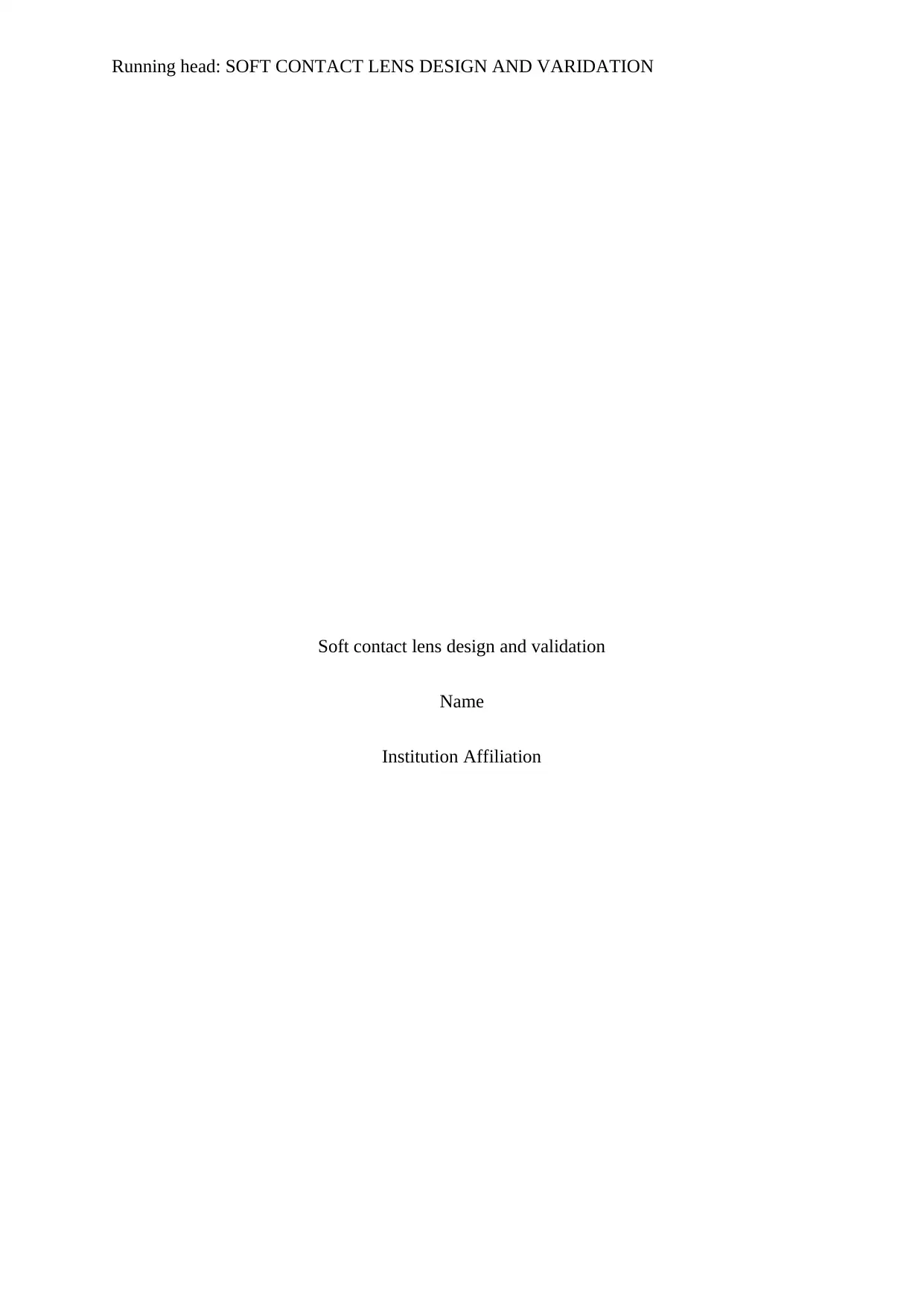
Running head: SOFT CONTACT LENS DESIGN AND VARIDATION
Soft contact lens design and validation
Name
Institution Affiliation
Soft contact lens design and validation
Name
Institution Affiliation
Paraphrase This Document
Need a fresh take? Get an instant paraphrase of this document with our AI Paraphraser
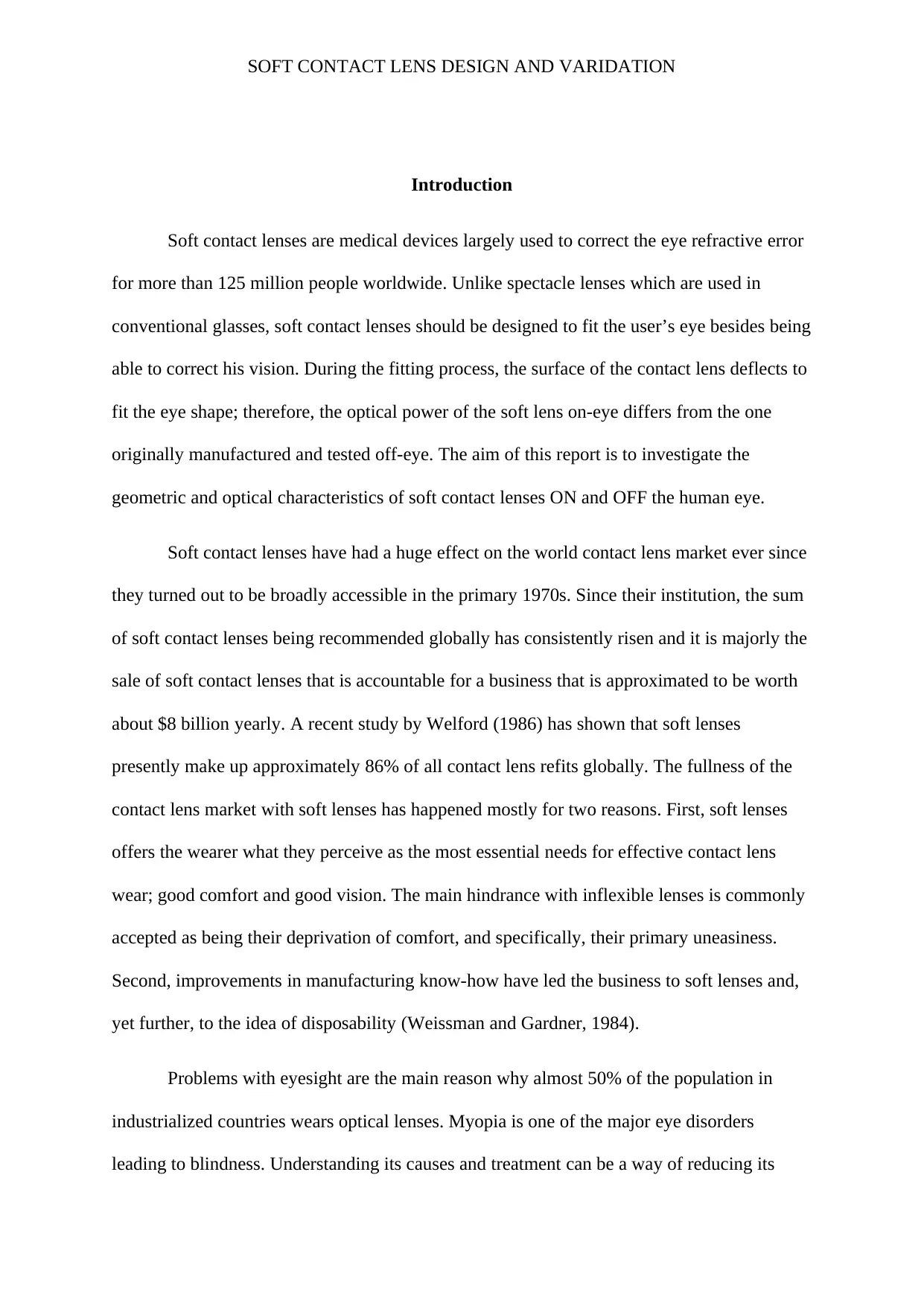
SOFT CONTACT LENS DESIGN AND VARIDATION
Introduction
Soft contact lenses are medical devices largely used to correct the eye refractive error
for more than 125 million people worldwide. Unlike spectacle lenses which are used in
conventional glasses, soft contact lenses should be designed to fit the user’s eye besides being
able to correct his vision. During the fitting process, the surface of the contact lens deflects to
fit the eye shape; therefore, the optical power of the soft lens on-eye differs from the one
originally manufactured and tested off-eye. The aim of this report is to investigate the
geometric and optical characteristics of soft contact lenses ON and OFF the human eye.
Soft contact lenses have had a huge effect on the world contact lens market ever since
they turned out to be broadly accessible in the primary 1970s. Since their institution, the sum
of soft contact lenses being recommended globally has consistently risen and it is majorly the
sale of soft contact lenses that is accountable for a business that is approximated to be worth
about $8 billion yearly. A recent study by Welford (1986) has shown that soft lenses
presently make up approximately 86% of all contact lens refits globally. The fullness of the
contact lens market with soft lenses has happened mostly for two reasons. First, soft lenses
offers the wearer what they perceive as the most essential needs for effective contact lens
wear; good comfort and good vision. The main hindrance with inflexible lenses is commonly
accepted as being their deprivation of comfort, and specifically, their primary uneasiness.
Second, improvements in manufacturing know-how have led the business to soft lenses and,
yet further, to the idea of disposability (Weissman and Gardner, 1984).
Problems with eyesight are the main reason why almost 50% of the population in
industrialized countries wears optical lenses. Myopia is one of the major eye disorders
leading to blindness. Understanding its causes and treatment can be a way of reducing its
Introduction
Soft contact lenses are medical devices largely used to correct the eye refractive error
for more than 125 million people worldwide. Unlike spectacle lenses which are used in
conventional glasses, soft contact lenses should be designed to fit the user’s eye besides being
able to correct his vision. During the fitting process, the surface of the contact lens deflects to
fit the eye shape; therefore, the optical power of the soft lens on-eye differs from the one
originally manufactured and tested off-eye. The aim of this report is to investigate the
geometric and optical characteristics of soft contact lenses ON and OFF the human eye.
Soft contact lenses have had a huge effect on the world contact lens market ever since
they turned out to be broadly accessible in the primary 1970s. Since their institution, the sum
of soft contact lenses being recommended globally has consistently risen and it is majorly the
sale of soft contact lenses that is accountable for a business that is approximated to be worth
about $8 billion yearly. A recent study by Welford (1986) has shown that soft lenses
presently make up approximately 86% of all contact lens refits globally. The fullness of the
contact lens market with soft lenses has happened mostly for two reasons. First, soft lenses
offers the wearer what they perceive as the most essential needs for effective contact lens
wear; good comfort and good vision. The main hindrance with inflexible lenses is commonly
accepted as being their deprivation of comfort, and specifically, their primary uneasiness.
Second, improvements in manufacturing know-how have led the business to soft lenses and,
yet further, to the idea of disposability (Weissman and Gardner, 1984).
Problems with eyesight are the main reason why almost 50% of the population in
industrialized countries wears optical lenses. Myopia is one of the major eye disorders
leading to blindness. Understanding its causes and treatment can be a way of reducing its
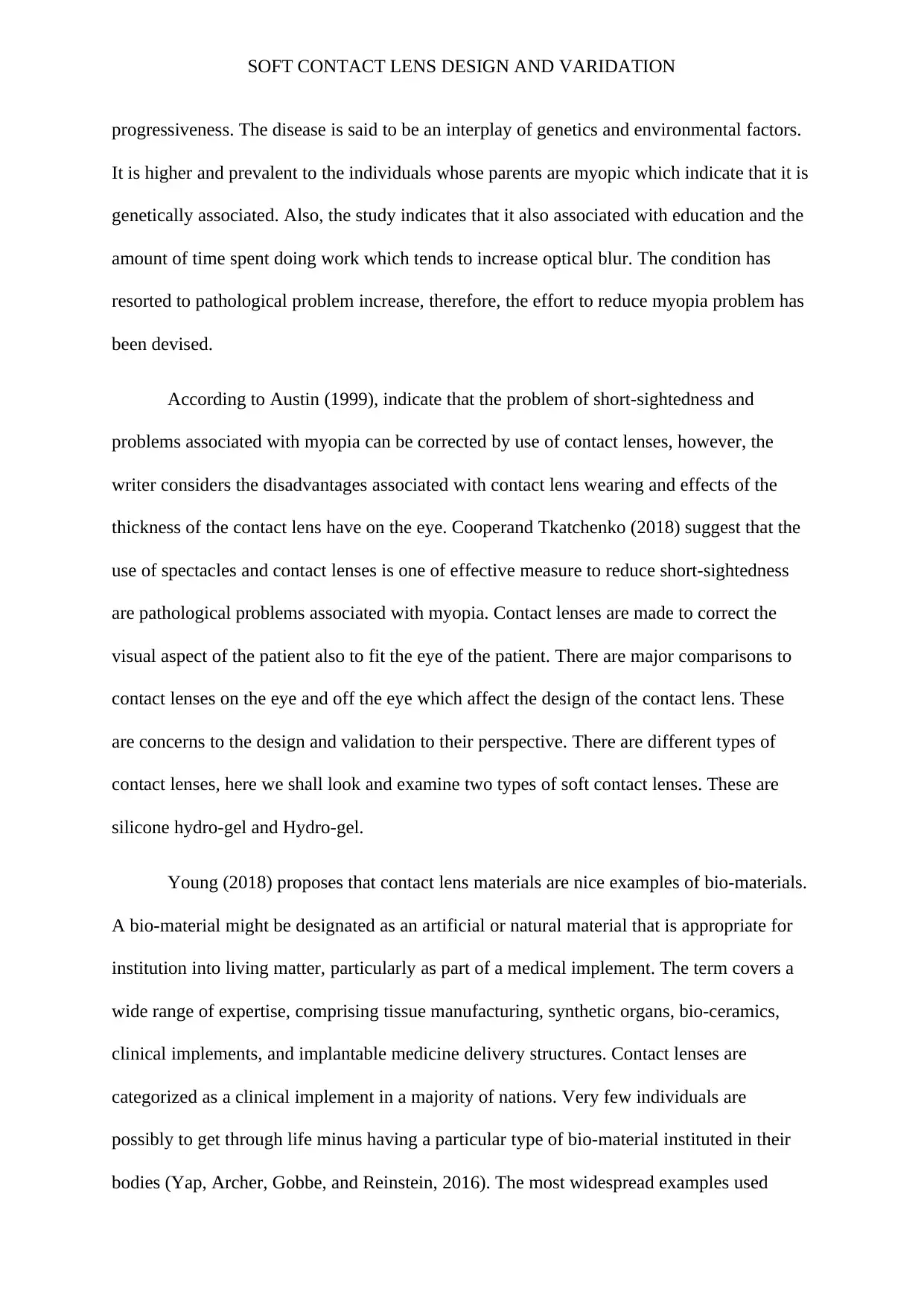
SOFT CONTACT LENS DESIGN AND VARIDATION
progressiveness. The disease is said to be an interplay of genetics and environmental factors.
It is higher and prevalent to the individuals whose parents are myopic which indicate that it is
genetically associated. Also, the study indicates that it also associated with education and the
amount of time spent doing work which tends to increase optical blur. The condition has
resorted to pathological problem increase, therefore, the effort to reduce myopia problem has
been devised.
According to Austin (1999), indicate that the problem of short-sightedness and
problems associated with myopia can be corrected by use of contact lenses, however, the
writer considers the disadvantages associated with contact lens wearing and effects of the
thickness of the contact lens have on the eye. Cooperand Tkatchenko (2018) suggest that the
use of spectacles and contact lenses is one of effective measure to reduce short-sightedness
are pathological problems associated with myopia. Contact lenses are made to correct the
visual aspect of the patient also to fit the eye of the patient. There are major comparisons to
contact lenses on the eye and off the eye which affect the design of the contact lens. These
are concerns to the design and validation to their perspective. There are different types of
contact lenses, here we shall look and examine two types of soft contact lenses. These are
silicone hydro-gel and Hydro-gel.
Young (2018) proposes that contact lens materials are nice examples of bio-materials.
A bio-material might be designated as an artificial or natural material that is appropriate for
institution into living matter, particularly as part of a medical implement. The term covers a
wide range of expertise, comprising tissue manufacturing, synthetic organs, bio-ceramics,
clinical implements, and implantable medicine delivery structures. Contact lenses are
categorized as a clinical implement in a majority of nations. Very few individuals are
possibly to get through life minus having a particular type of bio-material instituted in their
bodies (Yap, Archer, Gobbe, and Reinstein, 2016). The most widespread examples used
progressiveness. The disease is said to be an interplay of genetics and environmental factors.
It is higher and prevalent to the individuals whose parents are myopic which indicate that it is
genetically associated. Also, the study indicates that it also associated with education and the
amount of time spent doing work which tends to increase optical blur. The condition has
resorted to pathological problem increase, therefore, the effort to reduce myopia problem has
been devised.
According to Austin (1999), indicate that the problem of short-sightedness and
problems associated with myopia can be corrected by use of contact lenses, however, the
writer considers the disadvantages associated with contact lens wearing and effects of the
thickness of the contact lens have on the eye. Cooperand Tkatchenko (2018) suggest that the
use of spectacles and contact lenses is one of effective measure to reduce short-sightedness
are pathological problems associated with myopia. Contact lenses are made to correct the
visual aspect of the patient also to fit the eye of the patient. There are major comparisons to
contact lenses on the eye and off the eye which affect the design of the contact lens. These
are concerns to the design and validation to their perspective. There are different types of
contact lenses, here we shall look and examine two types of soft contact lenses. These are
silicone hydro-gel and Hydro-gel.
Young (2018) proposes that contact lens materials are nice examples of bio-materials.
A bio-material might be designated as an artificial or natural material that is appropriate for
institution into living matter, particularly as part of a medical implement. The term covers a
wide range of expertise, comprising tissue manufacturing, synthetic organs, bio-ceramics,
clinical implements, and implantable medicine delivery structures. Contact lenses are
categorized as a clinical implement in a majority of nations. Very few individuals are
possibly to get through life minus having a particular type of bio-material instituted in their
bodies (Yap, Archer, Gobbe, and Reinstein, 2016). The most widespread examples used
⊘ This is a preview!⊘
Do you want full access?
Subscribe today to unlock all pages.

Trusted by 1+ million students worldwide
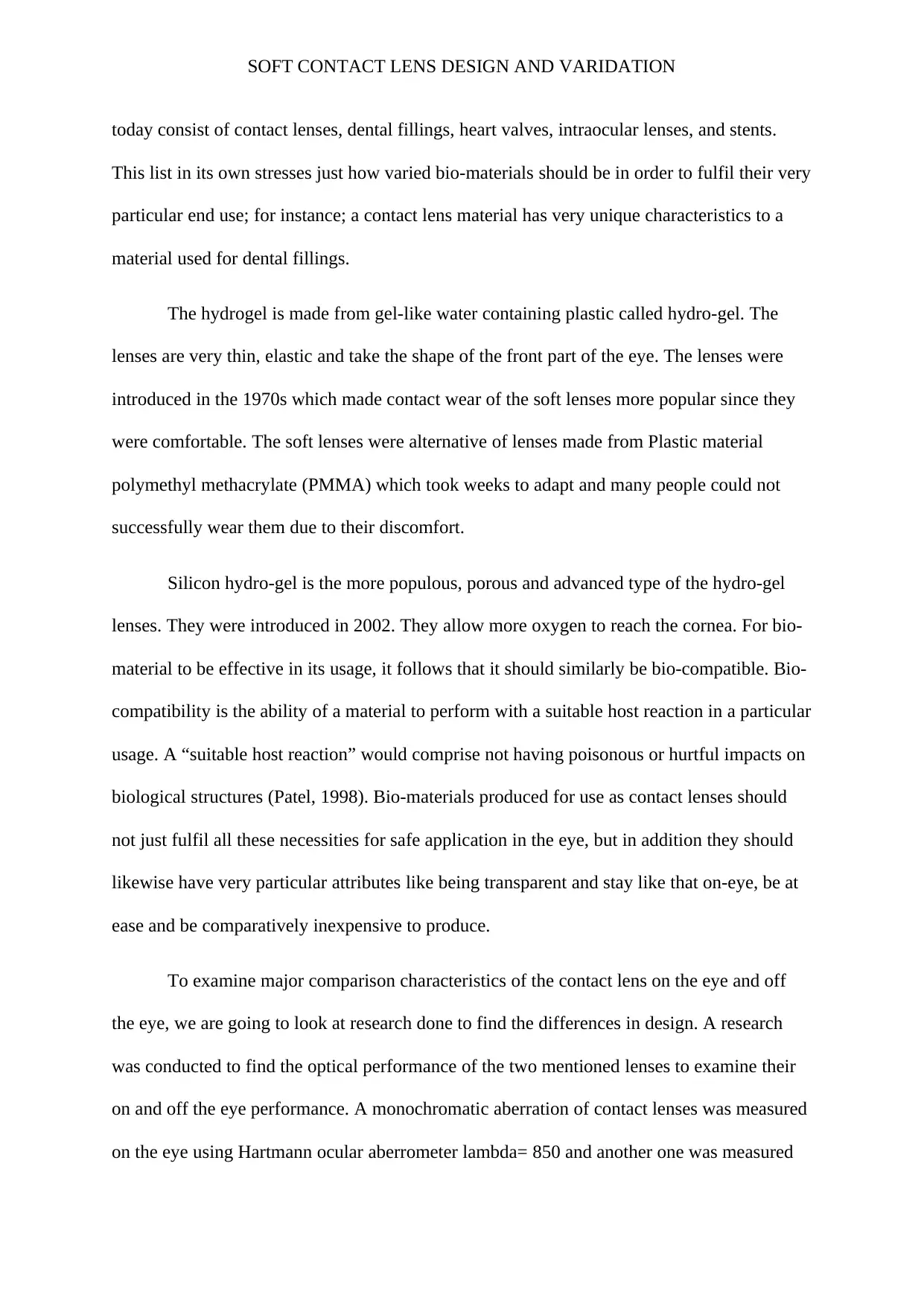
SOFT CONTACT LENS DESIGN AND VARIDATION
today consist of contact lenses, dental fillings, heart valves, intraocular lenses, and stents.
This list in its own stresses just how varied bio-materials should be in order to fulfil their very
particular end use; for instance; a contact lens material has very unique characteristics to a
material used for dental fillings.
The hydrogel is made from gel-like water containing plastic called hydro-gel. The
lenses are very thin, elastic and take the shape of the front part of the eye. The lenses were
introduced in the 1970s which made contact wear of the soft lenses more popular since they
were comfortable. The soft lenses were alternative of lenses made from Plastic material
polymethyl methacrylate (PMMA) which took weeks to adapt and many people could not
successfully wear them due to their discomfort.
Silicon hydro-gel is the more populous, porous and advanced type of the hydro-gel
lenses. They were introduced in 2002. They allow more oxygen to reach the cornea. For bio-
material to be effective in its usage, it follows that it should similarly be bio-compatible. Bio-
compatibility is the ability of a material to perform with a suitable host reaction in a particular
usage. A “suitable host reaction” would comprise not having poisonous or hurtful impacts on
biological structures (Patel, 1998). Bio-materials produced for use as contact lenses should
not just fulfil all these necessities for safe application in the eye, but in addition they should
likewise have very particular attributes like being transparent and stay like that on-eye, be at
ease and be comparatively inexpensive to produce.
To examine major comparison characteristics of the contact lens on the eye and off
the eye, we are going to look at research done to find the differences in design. A research
was conducted to find the optical performance of the two mentioned lenses to examine their
on and off the eye performance. A monochromatic aberration of contact lenses was measured
on the eye using Hartmann ocular aberrometer lambda= 850 and another one was measured
today consist of contact lenses, dental fillings, heart valves, intraocular lenses, and stents.
This list in its own stresses just how varied bio-materials should be in order to fulfil their very
particular end use; for instance; a contact lens material has very unique characteristics to a
material used for dental fillings.
The hydrogel is made from gel-like water containing plastic called hydro-gel. The
lenses are very thin, elastic and take the shape of the front part of the eye. The lenses were
introduced in the 1970s which made contact wear of the soft lenses more popular since they
were comfortable. The soft lenses were alternative of lenses made from Plastic material
polymethyl methacrylate (PMMA) which took weeks to adapt and many people could not
successfully wear them due to their discomfort.
Silicon hydro-gel is the more populous, porous and advanced type of the hydro-gel
lenses. They were introduced in 2002. They allow more oxygen to reach the cornea. For bio-
material to be effective in its usage, it follows that it should similarly be bio-compatible. Bio-
compatibility is the ability of a material to perform with a suitable host reaction in a particular
usage. A “suitable host reaction” would comprise not having poisonous or hurtful impacts on
biological structures (Patel, 1998). Bio-materials produced for use as contact lenses should
not just fulfil all these necessities for safe application in the eye, but in addition they should
likewise have very particular attributes like being transparent and stay like that on-eye, be at
ease and be comparatively inexpensive to produce.
To examine major comparison characteristics of the contact lens on the eye and off
the eye, we are going to look at research done to find the differences in design. A research
was conducted to find the optical performance of the two mentioned lenses to examine their
on and off the eye performance. A monochromatic aberration of contact lenses was measured
on the eye using Hartmann ocular aberrometer lambda= 850 and another one was measured
Paraphrase This Document
Need a fresh take? Get an instant paraphrase of this document with our AI Paraphraser
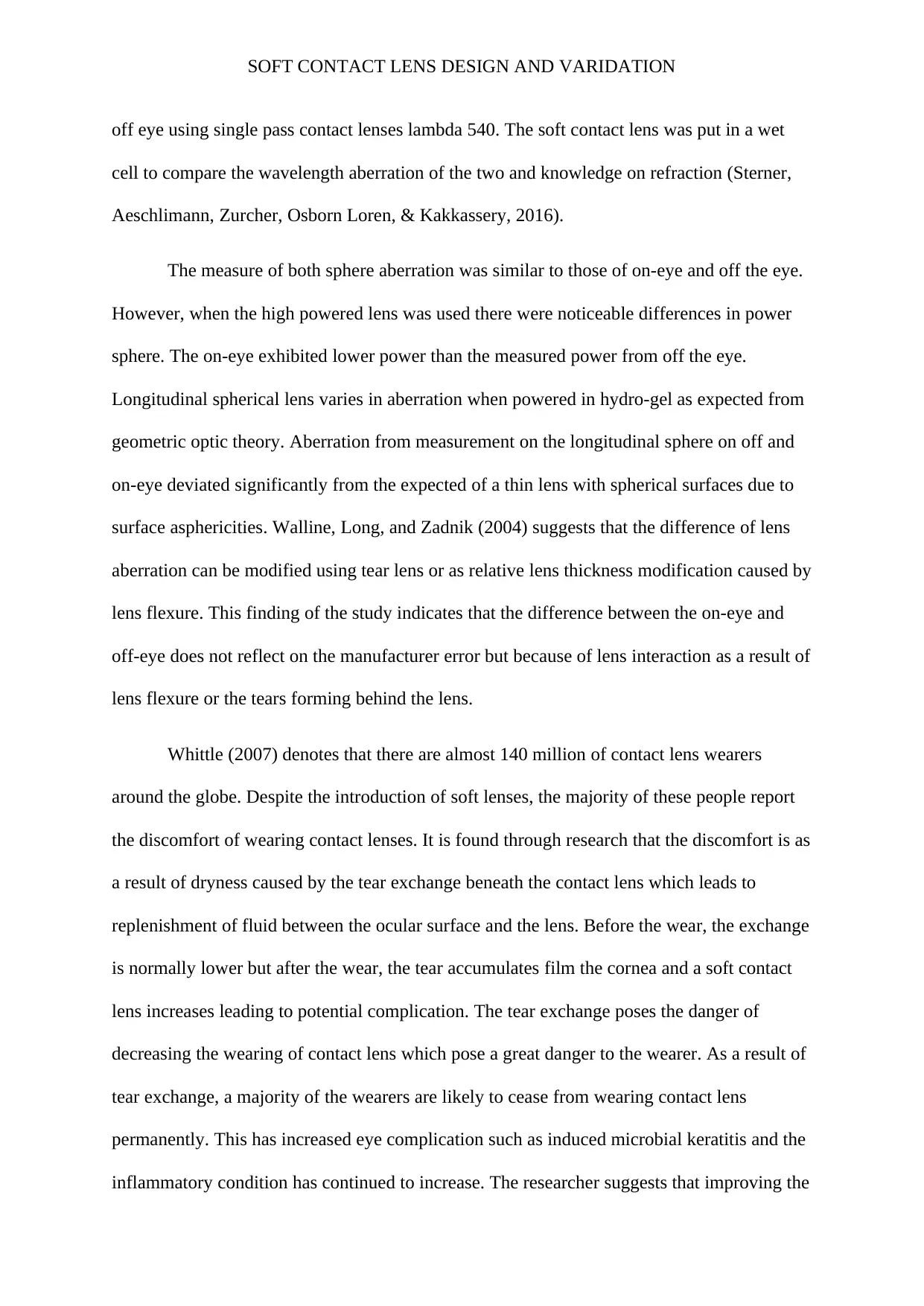
SOFT CONTACT LENS DESIGN AND VARIDATION
off eye using single pass contact lenses lambda 540. The soft contact lens was put in a wet
cell to compare the wavelength aberration of the two and knowledge on refraction (Sterner,
Aeschlimann, Zurcher, Osborn Loren, & Kakkassery, 2016).
The measure of both sphere aberration was similar to those of on-eye and off the eye.
However, when the high powered lens was used there were noticeable differences in power
sphere. The on-eye exhibited lower power than the measured power from off the eye.
Longitudinal spherical lens varies in aberration when powered in hydro-gel as expected from
geometric optic theory. Aberration from measurement on the longitudinal sphere on off and
on-eye deviated significantly from the expected of a thin lens with spherical surfaces due to
surface asphericities. Walline, Long, and Zadnik (2004) suggests that the difference of lens
aberration can be modified using tear lens or as relative lens thickness modification caused by
lens flexure. This finding of the study indicates that the difference between the on-eye and
off-eye does not reflect on the manufacturer error but because of lens interaction as a result of
lens flexure or the tears forming behind the lens.
Whittle (2007) denotes that there are almost 140 million of contact lens wearers
around the globe. Despite the introduction of soft lenses, the majority of these people report
the discomfort of wearing contact lenses. It is found through research that the discomfort is as
a result of dryness caused by the tear exchange beneath the contact lens which leads to
replenishment of fluid between the ocular surface and the lens. Before the wear, the exchange
is normally lower but after the wear, the tear accumulates film the cornea and a soft contact
lens increases leading to potential complication. The tear exchange poses the danger of
decreasing the wearing of contact lens which pose a great danger to the wearer. As a result of
tear exchange, a majority of the wearers are likely to cease from wearing contact lens
permanently. This has increased eye complication such as induced microbial keratitis and the
inflammatory condition has continued to increase. The researcher suggests that improving the
off eye using single pass contact lenses lambda 540. The soft contact lens was put in a wet
cell to compare the wavelength aberration of the two and knowledge on refraction (Sterner,
Aeschlimann, Zurcher, Osborn Loren, & Kakkassery, 2016).
The measure of both sphere aberration was similar to those of on-eye and off the eye.
However, when the high powered lens was used there were noticeable differences in power
sphere. The on-eye exhibited lower power than the measured power from off the eye.
Longitudinal spherical lens varies in aberration when powered in hydro-gel as expected from
geometric optic theory. Aberration from measurement on the longitudinal sphere on off and
on-eye deviated significantly from the expected of a thin lens with spherical surfaces due to
surface asphericities. Walline, Long, and Zadnik (2004) suggests that the difference of lens
aberration can be modified using tear lens or as relative lens thickness modification caused by
lens flexure. This finding of the study indicates that the difference between the on-eye and
off-eye does not reflect on the manufacturer error but because of lens interaction as a result of
lens flexure or the tears forming behind the lens.
Whittle (2007) denotes that there are almost 140 million of contact lens wearers
around the globe. Despite the introduction of soft lenses, the majority of these people report
the discomfort of wearing contact lenses. It is found through research that the discomfort is as
a result of dryness caused by the tear exchange beneath the contact lens which leads to
replenishment of fluid between the ocular surface and the lens. Before the wear, the exchange
is normally lower but after the wear, the tear accumulates film the cornea and a soft contact
lens increases leading to potential complication. The tear exchange poses the danger of
decreasing the wearing of contact lens which pose a great danger to the wearer. As a result of
tear exchange, a majority of the wearers are likely to cease from wearing contact lens
permanently. This has increased eye complication such as induced microbial keratitis and the
inflammatory condition has continued to increase. The researcher suggests that improving the

SOFT CONTACT LENS DESIGN AND VARIDATION
design of the contact lens may reduce increased of tear exchange and reduce the
inflammatory condition thus increase the number of contact lens wearers.
The research indicates that problem associated with eye discomfort is being looked
into by the researcher to resolve the dryness leading to discomfort by looking into the design
of the contact lens so as to reduce the tear exchange which will increase the number of
contact lens wearers (Sulley, Osborn Loren, Wolffsohn, and Yound, 2017). According to
other researches, the problems associated with contact eye discomfort are as a result of the
use of different contact lenses. These have contributed to the introduction of other types of
contact lenses as a way of finding a solution to contact lens discomfort. These findings bring
in the issue of introduction of other contact lenses as a solution to the eye discomfort. This
finding differs from another finding which suggests that the eye discomfort is not associated
with the contact lens the problem is associated with wearing of contact lenses there other
problems that lead to eye damages.
The experiment was done to assess the effect of eye rubbing on corneal thickness and
intraocular pressure measurement obtained 0-30 min after habitual eye rubbing. IOP and CT
were obtained from five different locations of the eye. The results indicated that the
consistency in eye rubbing reduced the thickening of the cornea with minimal results. This
was considered not clinically relevant. To solve the problem associated with contact eyes and
discomfort various approaches, Strachan (1973) examines the correlations between solution
component, keratitis and contact lens discomfort. The study suggests that selection of
multipurpose lens solution and hydrogen peroxide-based solution should be available in the
clinics for patients to have access. The study suggests that the cause of discomfort is as a
result of the problem associated with keratitis inflammation associated with contact lens.
design of the contact lens may reduce increased of tear exchange and reduce the
inflammatory condition thus increase the number of contact lens wearers.
The research indicates that problem associated with eye discomfort is being looked
into by the researcher to resolve the dryness leading to discomfort by looking into the design
of the contact lens so as to reduce the tear exchange which will increase the number of
contact lens wearers (Sulley, Osborn Loren, Wolffsohn, and Yound, 2017). According to
other researches, the problems associated with contact eye discomfort are as a result of the
use of different contact lenses. These have contributed to the introduction of other types of
contact lenses as a way of finding a solution to contact lens discomfort. These findings bring
in the issue of introduction of other contact lenses as a solution to the eye discomfort. This
finding differs from another finding which suggests that the eye discomfort is not associated
with the contact lens the problem is associated with wearing of contact lenses there other
problems that lead to eye damages.
The experiment was done to assess the effect of eye rubbing on corneal thickness and
intraocular pressure measurement obtained 0-30 min after habitual eye rubbing. IOP and CT
were obtained from five different locations of the eye. The results indicated that the
consistency in eye rubbing reduced the thickening of the cornea with minimal results. This
was considered not clinically relevant. To solve the problem associated with contact eyes and
discomfort various approaches, Strachan (1973) examines the correlations between solution
component, keratitis and contact lens discomfort. The study suggests that selection of
multipurpose lens solution and hydrogen peroxide-based solution should be available in the
clinics for patients to have access. The study suggests that the cause of discomfort is as a
result of the problem associated with keratitis inflammation associated with contact lens.
⊘ This is a preview!⊘
Do you want full access?
Subscribe today to unlock all pages.

Trusted by 1+ million students worldwide
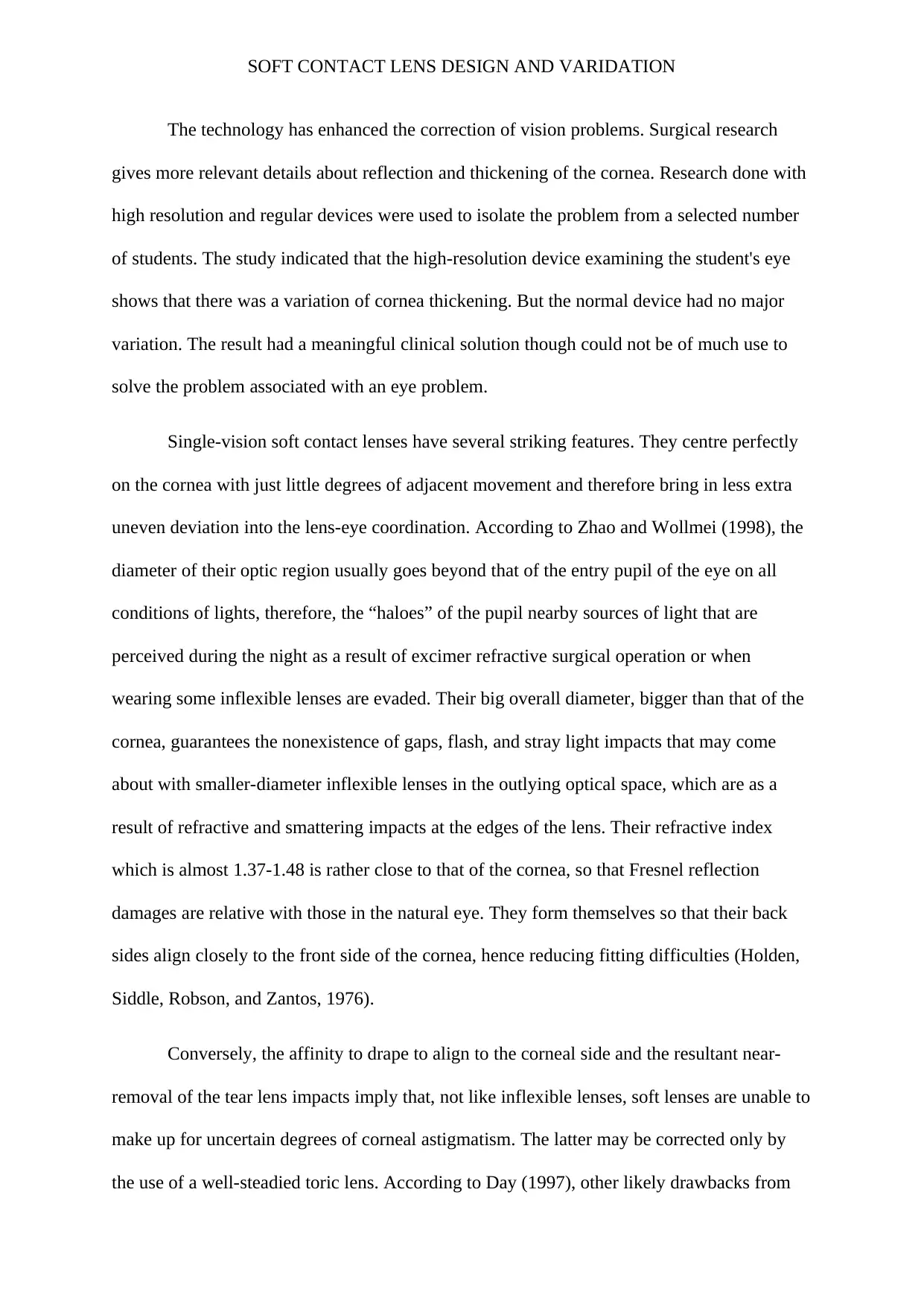
SOFT CONTACT LENS DESIGN AND VARIDATION
The technology has enhanced the correction of vision problems. Surgical research
gives more relevant details about reflection and thickening of the cornea. Research done with
high resolution and regular devices were used to isolate the problem from a selected number
of students. The study indicated that the high-resolution device examining the student's eye
shows that there was a variation of cornea thickening. But the normal device had no major
variation. The result had a meaningful clinical solution though could not be of much use to
solve the problem associated with an eye problem.
Single-vision soft contact lenses have several striking features. They centre perfectly
on the cornea with just little degrees of adjacent movement and therefore bring in less extra
uneven deviation into the lens-eye coordination. According to Zhao and Wollmei (1998), the
diameter of their optic region usually goes beyond that of the entry pupil of the eye on all
conditions of lights, therefore, the “haloes” of the pupil nearby sources of light that are
perceived during the night as a result of excimer refractive surgical operation or when
wearing some inflexible lenses are evaded. Their big overall diameter, bigger than that of the
cornea, guarantees the nonexistence of gaps, flash, and stray light impacts that may come
about with smaller-diameter inflexible lenses in the outlying optical space, which are as a
result of refractive and smattering impacts at the edges of the lens. Their refractive index
which is almost 1.37-1.48 is rather close to that of the cornea, so that Fresnel reflection
damages are relative with those in the natural eye. They form themselves so that their back
sides align closely to the front side of the cornea, hence reducing fitting difficulties (Holden,
Siddle, Robson, and Zantos, 1976).
Conversely, the affinity to drape to align to the corneal side and the resultant near-
removal of the tear lens impacts imply that, not like inflexible lenses, soft lenses are unable to
make up for uncertain degrees of corneal astigmatism. The latter may be corrected only by
the use of a well-steadied toric lens. According to Day (1997), other likely drawbacks from
The technology has enhanced the correction of vision problems. Surgical research
gives more relevant details about reflection and thickening of the cornea. Research done with
high resolution and regular devices were used to isolate the problem from a selected number
of students. The study indicated that the high-resolution device examining the student's eye
shows that there was a variation of cornea thickening. But the normal device had no major
variation. The result had a meaningful clinical solution though could not be of much use to
solve the problem associated with an eye problem.
Single-vision soft contact lenses have several striking features. They centre perfectly
on the cornea with just little degrees of adjacent movement and therefore bring in less extra
uneven deviation into the lens-eye coordination. According to Zhao and Wollmei (1998), the
diameter of their optic region usually goes beyond that of the entry pupil of the eye on all
conditions of lights, therefore, the “haloes” of the pupil nearby sources of light that are
perceived during the night as a result of excimer refractive surgical operation or when
wearing some inflexible lenses are evaded. Their big overall diameter, bigger than that of the
cornea, guarantees the nonexistence of gaps, flash, and stray light impacts that may come
about with smaller-diameter inflexible lenses in the outlying optical space, which are as a
result of refractive and smattering impacts at the edges of the lens. Their refractive index
which is almost 1.37-1.48 is rather close to that of the cornea, so that Fresnel reflection
damages are relative with those in the natural eye. They form themselves so that their back
sides align closely to the front side of the cornea, hence reducing fitting difficulties (Holden,
Siddle, Robson, and Zantos, 1976).
Conversely, the affinity to drape to align to the corneal side and the resultant near-
removal of the tear lens impacts imply that, not like inflexible lenses, soft lenses are unable to
make up for uncertain degrees of corneal astigmatism. The latter may be corrected only by
the use of a well-steadied toric lens. According to Day (1997), other likely drawbacks from
Paraphrase This Document
Need a fresh take? Get an instant paraphrase of this document with our AI Paraphraser
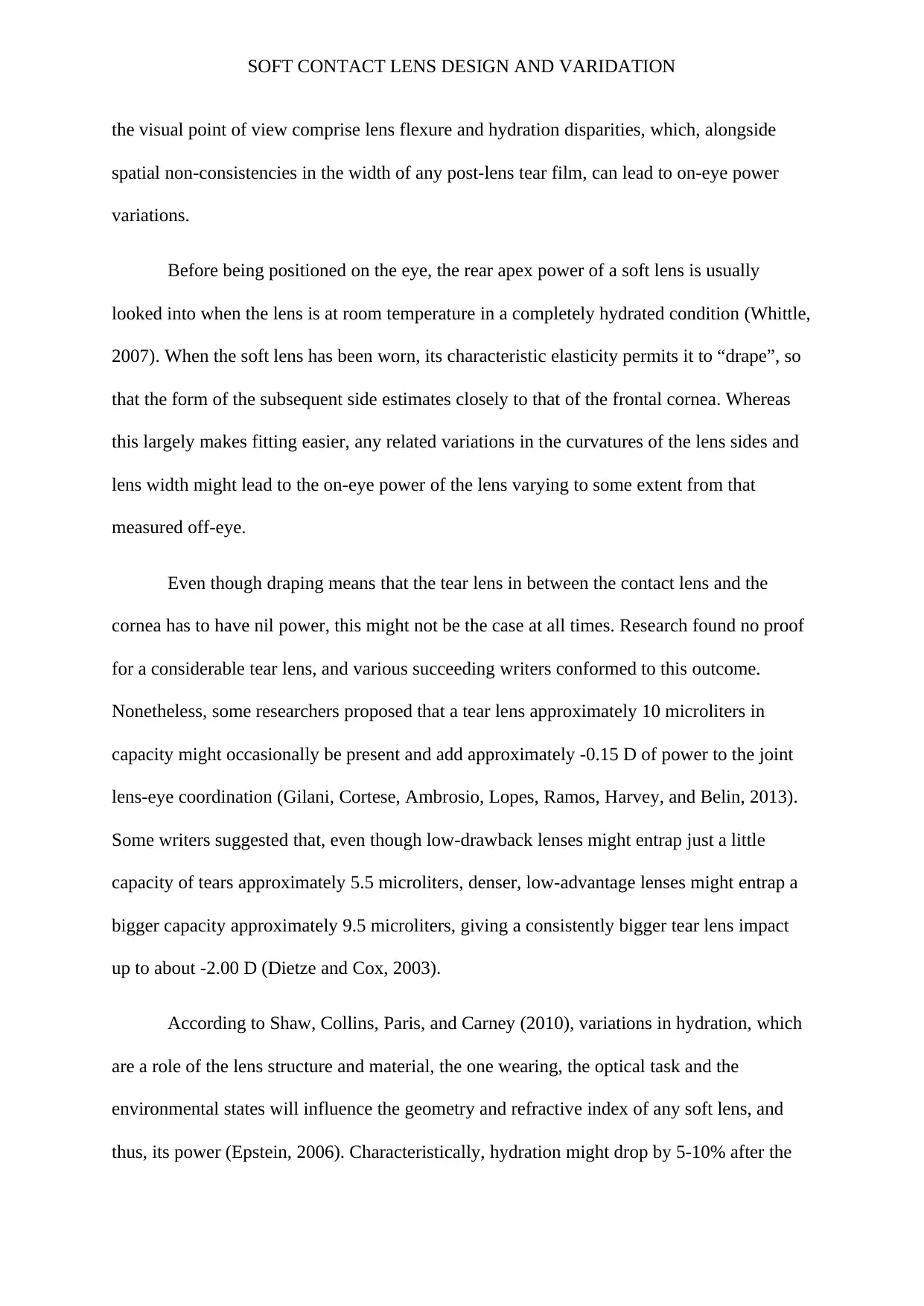
SOFT CONTACT LENS DESIGN AND VARIDATION
the visual point of view comprise lens flexure and hydration disparities, which, alongside
spatial non-consistencies in the width of any post-lens tear film, can lead to on-eye power
variations.
Before being positioned on the eye, the rear apex power of a soft lens is usually
looked into when the lens is at room temperature in a completely hydrated condition (Whittle,
2007). When the soft lens has been worn, its characteristic elasticity permits it to “drape”, so
that the form of the subsequent side estimates closely to that of the frontal cornea. Whereas
this largely makes fitting easier, any related variations in the curvatures of the lens sides and
lens width might lead to the on-eye power of the lens varying to some extent from that
measured off-eye.
Even though draping means that the tear lens in between the contact lens and the
cornea has to have nil power, this might not be the case at all times. Research found no proof
for a considerable tear lens, and various succeeding writers conformed to this outcome.
Nonetheless, some researchers proposed that a tear lens approximately 10 microliters in
capacity might occasionally be present and add approximately -0.15 D of power to the joint
lens-eye coordination (Gilani, Cortese, Ambrosio, Lopes, Ramos, Harvey, and Belin, 2013).
Some writers suggested that, even though low-drawback lenses might entrap just a little
capacity of tears approximately 5.5 microliters, denser, low-advantage lenses might entrap a
bigger capacity approximately 9.5 microliters, giving a consistently bigger tear lens impact
up to about -2.00 D (Dietze and Cox, 2003).
According to Shaw, Collins, Paris, and Carney (2010), variations in hydration, which
are a role of the lens structure and material, the one wearing, the optical task and the
environmental states will influence the geometry and refractive index of any soft lens, and
thus, its power (Epstein, 2006). Characteristically, hydration might drop by 5-10% after the
the visual point of view comprise lens flexure and hydration disparities, which, alongside
spatial non-consistencies in the width of any post-lens tear film, can lead to on-eye power
variations.
Before being positioned on the eye, the rear apex power of a soft lens is usually
looked into when the lens is at room temperature in a completely hydrated condition (Whittle,
2007). When the soft lens has been worn, its characteristic elasticity permits it to “drape”, so
that the form of the subsequent side estimates closely to that of the frontal cornea. Whereas
this largely makes fitting easier, any related variations in the curvatures of the lens sides and
lens width might lead to the on-eye power of the lens varying to some extent from that
measured off-eye.
Even though draping means that the tear lens in between the contact lens and the
cornea has to have nil power, this might not be the case at all times. Research found no proof
for a considerable tear lens, and various succeeding writers conformed to this outcome.
Nonetheless, some researchers proposed that a tear lens approximately 10 microliters in
capacity might occasionally be present and add approximately -0.15 D of power to the joint
lens-eye coordination (Gilani, Cortese, Ambrosio, Lopes, Ramos, Harvey, and Belin, 2013).
Some writers suggested that, even though low-drawback lenses might entrap just a little
capacity of tears approximately 5.5 microliters, denser, low-advantage lenses might entrap a
bigger capacity approximately 9.5 microliters, giving a consistently bigger tear lens impact
up to about -2.00 D (Dietze and Cox, 2003).
According to Shaw, Collins, Paris, and Carney (2010), variations in hydration, which
are a role of the lens structure and material, the one wearing, the optical task and the
environmental states will influence the geometry and refractive index of any soft lens, and
thus, its power (Epstein, 2006). Characteristically, hydration might drop by 5-10% after the

SOFT CONTACT LENS DESIGN AND VARIDATION
first sixty minutes of wearing the lens. Thinner lenses attain a state of balance after almost
five minutes, while denser, high-power constructive lenses might still dehydrate for another
half an hour of more after attachment. Impacts seem to be material reliant, specifically, high-
water-content lenses dehydrate more and attain a state of balance earlier than lower-water-
content lenses of equivalent width. Cooper and Tkatchenko (2018) denote that there is a
sturdy proposition that bigger dehydration might happen in the course of near work, owing to
lessened blinking, and when the humidity in the atmosphere is low. Water loss may happen
by a number of paths, comprising evaporation into the air, draining into the nasolacrimal
structure and, probably, uptake into the conjunctival capillaries.
Since the temperature in the cornea is about 32-35 degrees Celsius, whereas the room
temperature is usually around 20 degrees Celsius, there is a temperature variation when the
lens is placed on the eye; this influences all the lens factors comprising refractive index and
hydration (Schiefer, Bernsten, Simott, Biokle, Gostric, et al. 2018). The measurements made
on a number of soft lens materials by Davis (2004), however, propose that the optimum rise
in (nl-1), where nl is the refractive index of the lens, is just approximately 1 part in 40 for a
temperature increase of 14 degrees Celsius, so that the related power variation in a lens of
such material would just be around 0.35 D for a plus or minus 10 D lens.
Numerous writers have attempted to come up with either empirical or theoretical
exemplars to enable on-eye power variations to be projected (Astin, 1999). Amongst the
more arithmetically refined models of flexure only are those founded on the idea that the
stretched lens usually maintains perpetual capacity or that the arc measurement of the rear
optic region of the lens remains perpetual. Experimental investigations, whose outcomes
comprise the impacts of all the aspects mentioned, not only those of flexure, approve in
showing that any power variations are slight for negative lenses but that bigger, medically
first sixty minutes of wearing the lens. Thinner lenses attain a state of balance after almost
five minutes, while denser, high-power constructive lenses might still dehydrate for another
half an hour of more after attachment. Impacts seem to be material reliant, specifically, high-
water-content lenses dehydrate more and attain a state of balance earlier than lower-water-
content lenses of equivalent width. Cooper and Tkatchenko (2018) denote that there is a
sturdy proposition that bigger dehydration might happen in the course of near work, owing to
lessened blinking, and when the humidity in the atmosphere is low. Water loss may happen
by a number of paths, comprising evaporation into the air, draining into the nasolacrimal
structure and, probably, uptake into the conjunctival capillaries.
Since the temperature in the cornea is about 32-35 degrees Celsius, whereas the room
temperature is usually around 20 degrees Celsius, there is a temperature variation when the
lens is placed on the eye; this influences all the lens factors comprising refractive index and
hydration (Schiefer, Bernsten, Simott, Biokle, Gostric, et al. 2018). The measurements made
on a number of soft lens materials by Davis (2004), however, propose that the optimum rise
in (nl-1), where nl is the refractive index of the lens, is just approximately 1 part in 40 for a
temperature increase of 14 degrees Celsius, so that the related power variation in a lens of
such material would just be around 0.35 D for a plus or minus 10 D lens.
Numerous writers have attempted to come up with either empirical or theoretical
exemplars to enable on-eye power variations to be projected (Astin, 1999). Amongst the
more arithmetically refined models of flexure only are those founded on the idea that the
stretched lens usually maintains perpetual capacity or that the arc measurement of the rear
optic region of the lens remains perpetual. Experimental investigations, whose outcomes
comprise the impacts of all the aspects mentioned, not only those of flexure, approve in
showing that any power variations are slight for negative lenses but that bigger, medically
⊘ This is a preview!⊘
Do you want full access?
Subscribe today to unlock all pages.

Trusted by 1+ million students worldwide
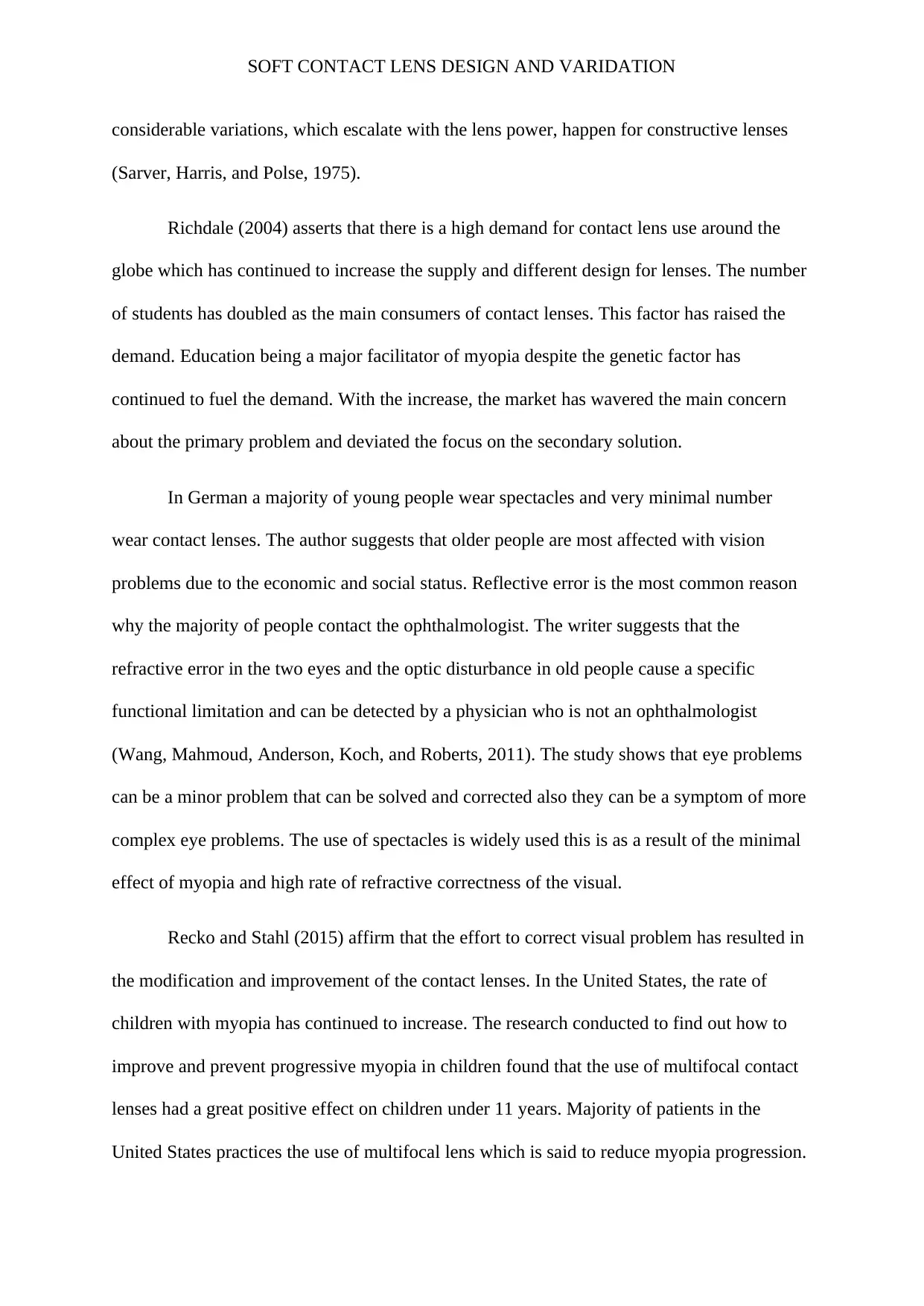
SOFT CONTACT LENS DESIGN AND VARIDATION
considerable variations, which escalate with the lens power, happen for constructive lenses
(Sarver, Harris, and Polse, 1975).
Richdale (2004) asserts that there is a high demand for contact lens use around the
globe which has continued to increase the supply and different design for lenses. The number
of students has doubled as the main consumers of contact lenses. This factor has raised the
demand. Education being a major facilitator of myopia despite the genetic factor has
continued to fuel the demand. With the increase, the market has wavered the main concern
about the primary problem and deviated the focus on the secondary solution.
In German a majority of young people wear spectacles and very minimal number
wear contact lenses. The author suggests that older people are most affected with vision
problems due to the economic and social status. Reflective error is the most common reason
why the majority of people contact the ophthalmologist. The writer suggests that the
refractive error in the two eyes and the optic disturbance in old people cause a specific
functional limitation and can be detected by a physician who is not an ophthalmologist
(Wang, Mahmoud, Anderson, Koch, and Roberts, 2011). The study shows that eye problems
can be a minor problem that can be solved and corrected also they can be a symptom of more
complex eye problems. The use of spectacles is widely used this is as a result of the minimal
effect of myopia and high rate of refractive correctness of the visual.
Recko and Stahl (2015) affirm that the effort to correct visual problem has resulted in
the modification and improvement of the contact lenses. In the United States, the rate of
children with myopia has continued to increase. The research conducted to find out how to
improve and prevent progressive myopia in children found that the use of multifocal contact
lenses had a great positive effect on children under 11 years. Majority of patients in the
United States practices the use of multifocal lens which is said to reduce myopia progression.
considerable variations, which escalate with the lens power, happen for constructive lenses
(Sarver, Harris, and Polse, 1975).
Richdale (2004) asserts that there is a high demand for contact lens use around the
globe which has continued to increase the supply and different design for lenses. The number
of students has doubled as the main consumers of contact lenses. This factor has raised the
demand. Education being a major facilitator of myopia despite the genetic factor has
continued to fuel the demand. With the increase, the market has wavered the main concern
about the primary problem and deviated the focus on the secondary solution.
In German a majority of young people wear spectacles and very minimal number
wear contact lenses. The author suggests that older people are most affected with vision
problems due to the economic and social status. Reflective error is the most common reason
why the majority of people contact the ophthalmologist. The writer suggests that the
refractive error in the two eyes and the optic disturbance in old people cause a specific
functional limitation and can be detected by a physician who is not an ophthalmologist
(Wang, Mahmoud, Anderson, Koch, and Roberts, 2011). The study shows that eye problems
can be a minor problem that can be solved and corrected also they can be a symptom of more
complex eye problems. The use of spectacles is widely used this is as a result of the minimal
effect of myopia and high rate of refractive correctness of the visual.
Recko and Stahl (2015) affirm that the effort to correct visual problem has resulted in
the modification and improvement of the contact lenses. In the United States, the rate of
children with myopia has continued to increase. The research conducted to find out how to
improve and prevent progressive myopia in children found that the use of multifocal contact
lenses had a great positive effect on children under 11 years. Majority of patients in the
United States practices the use of multifocal lens which is said to reduce myopia progression.
Paraphrase This Document
Need a fresh take? Get an instant paraphrase of this document with our AI Paraphraser
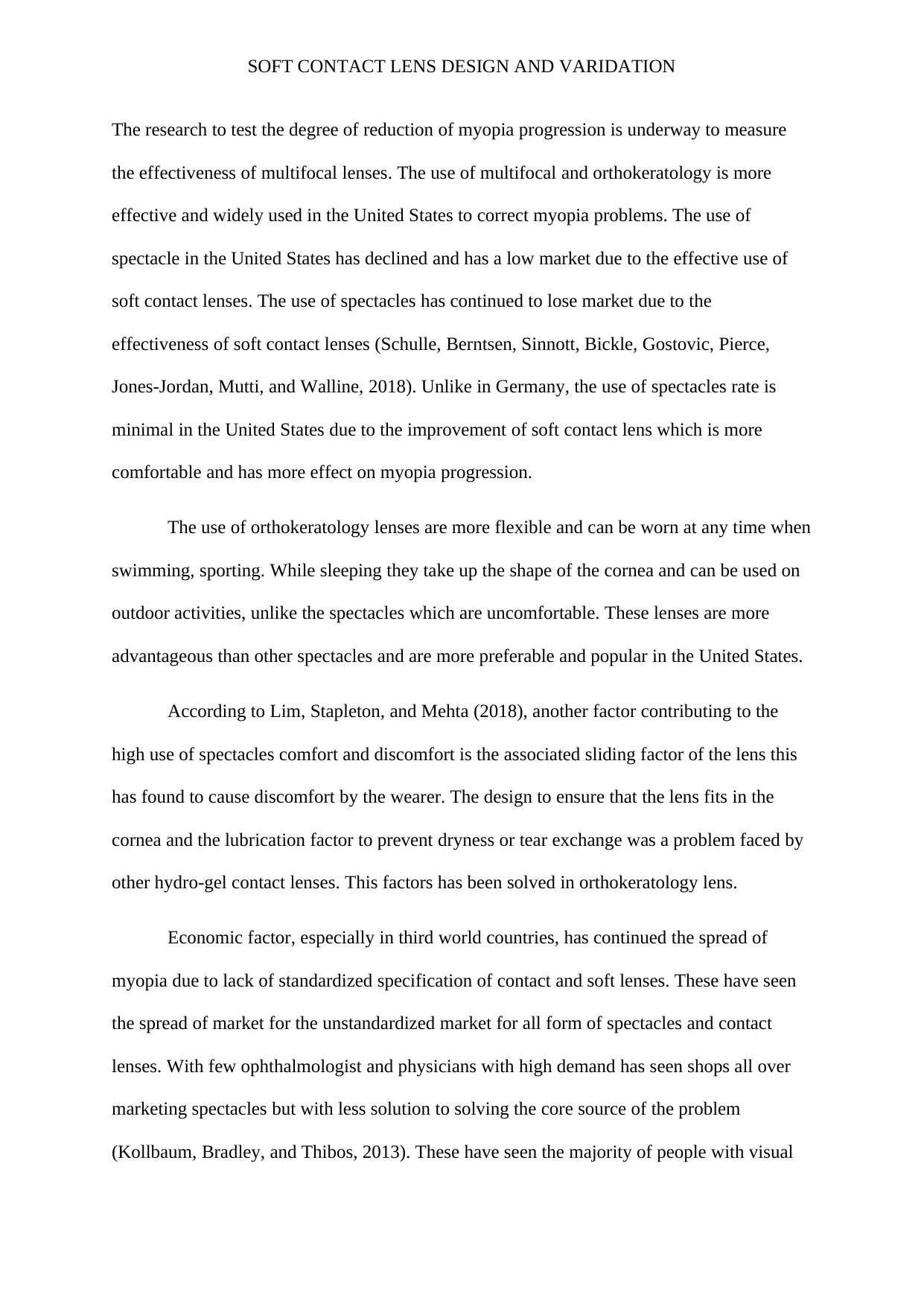
SOFT CONTACT LENS DESIGN AND VARIDATION
The research to test the degree of reduction of myopia progression is underway to measure
the effectiveness of multifocal lenses. The use of multifocal and orthokeratology is more
effective and widely used in the United States to correct myopia problems. The use of
spectacle in the United States has declined and has a low market due to the effective use of
soft contact lenses. The use of spectacles has continued to lose market due to the
effectiveness of soft contact lenses (Schulle, Berntsen, Sinnott, Bickle, Gostovic, Pierce,
Jones-Jordan, Mutti, and Walline, 2018). Unlike in Germany, the use of spectacles rate is
minimal in the United States due to the improvement of soft contact lens which is more
comfortable and has more effect on myopia progression.
The use of orthokeratology lenses are more flexible and can be worn at any time when
swimming, sporting. While sleeping they take up the shape of the cornea and can be used on
outdoor activities, unlike the spectacles which are uncomfortable. These lenses are more
advantageous than other spectacles and are more preferable and popular in the United States.
According to Lim, Stapleton, and Mehta (2018), another factor contributing to the
high use of spectacles comfort and discomfort is the associated sliding factor of the lens this
has found to cause discomfort by the wearer. The design to ensure that the lens fits in the
cornea and the lubrication factor to prevent dryness or tear exchange was a problem faced by
other hydro-gel contact lenses. This factors has been solved in orthokeratology lens.
Economic factor, especially in third world countries, has continued the spread of
myopia due to lack of standardized specification of contact and soft lenses. These have seen
the spread of market for the unstandardized market for all form of spectacles and contact
lenses. With few ophthalmologist and physicians with high demand has seen shops all over
marketing spectacles but with less solution to solving the core source of the problem
(Kollbaum, Bradley, and Thibos, 2013). These have seen the majority of people with visual
The research to test the degree of reduction of myopia progression is underway to measure
the effectiveness of multifocal lenses. The use of multifocal and orthokeratology is more
effective and widely used in the United States to correct myopia problems. The use of
spectacle in the United States has declined and has a low market due to the effective use of
soft contact lenses. The use of spectacles has continued to lose market due to the
effectiveness of soft contact lenses (Schulle, Berntsen, Sinnott, Bickle, Gostovic, Pierce,
Jones-Jordan, Mutti, and Walline, 2018). Unlike in Germany, the use of spectacles rate is
minimal in the United States due to the improvement of soft contact lens which is more
comfortable and has more effect on myopia progression.
The use of orthokeratology lenses are more flexible and can be worn at any time when
swimming, sporting. While sleeping they take up the shape of the cornea and can be used on
outdoor activities, unlike the spectacles which are uncomfortable. These lenses are more
advantageous than other spectacles and are more preferable and popular in the United States.
According to Lim, Stapleton, and Mehta (2018), another factor contributing to the
high use of spectacles comfort and discomfort is the associated sliding factor of the lens this
has found to cause discomfort by the wearer. The design to ensure that the lens fits in the
cornea and the lubrication factor to prevent dryness or tear exchange was a problem faced by
other hydro-gel contact lenses. This factors has been solved in orthokeratology lens.
Economic factor, especially in third world countries, has continued the spread of
myopia due to lack of standardized specification of contact and soft lenses. These have seen
the spread of market for the unstandardized market for all form of spectacles and contact
lenses. With few ophthalmologist and physicians with high demand has seen shops all over
marketing spectacles but with less solution to solving the core source of the problem
(Kollbaum, Bradley, and Thibos, 2013). These have seen the majority of people with visual

SOFT CONTACT LENS DESIGN AND VARIDATION
problems left with the option of buying spectacles after a specified period with no conclusive
solution.
Lack of information and research to find a conclusive solution to myopia has
continued to stimulate the use of spectacles with few alternatives to soft lenses which rare to
undeveloped countries with low-income economic background (Kalogeropoulos, Chang,
Bolton, and Jalbert, 2009). Lack of the availability of soft contact lens in many countries and
the lack of awareness about the solution to prevent progressiveness of myopia will continue
to stimulate the use of spectacles and contact lens that cause discomfort. Also economic
status play the key role due to high demand and unavailability of a conclusive solution.
problems left with the option of buying spectacles after a specified period with no conclusive
solution.
Lack of information and research to find a conclusive solution to myopia has
continued to stimulate the use of spectacles with few alternatives to soft lenses which rare to
undeveloped countries with low-income economic background (Kalogeropoulos, Chang,
Bolton, and Jalbert, 2009). Lack of the availability of soft contact lens in many countries and
the lack of awareness about the solution to prevent progressiveness of myopia will continue
to stimulate the use of spectacles and contact lens that cause discomfort. Also economic
status play the key role due to high demand and unavailability of a conclusive solution.
⊘ This is a preview!⊘
Do you want full access?
Subscribe today to unlock all pages.

Trusted by 1+ million students worldwide
1 out of 16
Your All-in-One AI-Powered Toolkit for Academic Success.
+13062052269
info@desklib.com
Available 24*7 on WhatsApp / Email
![[object Object]](/_next/static/media/star-bottom.7253800d.svg)
Unlock your academic potential
Copyright © 2020–2025 A2Z Services. All Rights Reserved. Developed and managed by ZUCOL.

